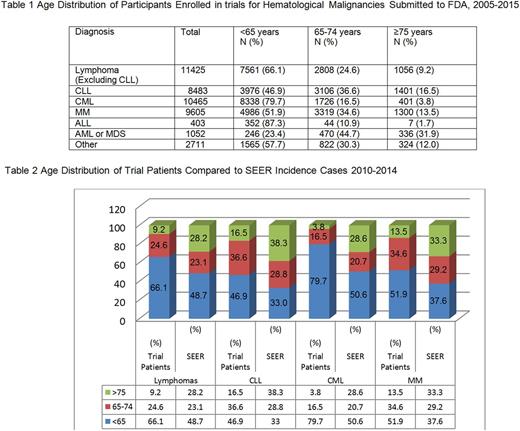Abstract

Background: The majority of hematologic malignancies are most frequently diagnosed in patients over 65 years of age (1). However, older adults are underrepresented in clinical trials evaluating new cancer therapies (2). This analysis quantifies age related enrollment in trials evaluating patients with hematologic malignancies submitted to FDA in support of drug approval.
Methods: We retrospectively analyzed demographic datasets of patients enrolled to trials submitted to FDA in support of approval of new or supplemental indications for hematologic cancer therapies from 2005-2015. Patients enrolled in trials for hematologic malignancies were grouped into disease categories based on the diagnosis specified for trial entry and analyzed according to age distributions of <65, 65-74 and ≥ 75 years. The rates of enrollment for patients with chronic myeloid leukemia (CML), chronic lymphocytic leukemia (CLL), multiple myeloma (MM) and lymphomas (Hodgkin's and non-Hodgkin's lymphoma excluding CLL) were compared with the age distribution of incidence cases by site derived from the Surveillance, Epidemiology, and End Results (SEER) Program of the National Cancer Institute 2010-2014 (1).
Results: We identified a total of 44,144 patients enrolled in clinical trials evaluating hematologic malignancies. Forty five percent (19908) of the patients were enrolled in lymphoma trials, 24% (10465) in chronic myeloid leukemia (CML) trials, 22% (9605) in multiple myeloma (MM) trials, 2% (1052) in acute myeloid leukemia (AML) or myelodysplastic syndrome (MDS) trials and 6% were enrolled in trials classified as "other" (includes myeloproliferative neoplasms and trials enrolling multiple malignancies). Less than 1% (403) of patients were enrolled in acute lymphoblastic leukemia (ALL) trials. Greater than 50% of the patients with the exception of those enrolled in CLL and AML/MDS trials were <65 years of age. Greater than 85% of the participants in ALL trials were < 65 years of age.
Compared to the U.S cancer population, clinical trials for lymphomas, CLL, CML and MM enrolled a disproportionately higher percentage of patients <65 years of age (Table 2). For participants ≥65 years in the lymphoma and CML trials, enrollment in the 65-74 year old age group was lower than the SEER incidence cases (24.6% versus 23.1% for lymphoma and 16.5% versus 20.7% for CML respectively); but the difference was less than 5%. CLL and MM trials enrolled a higher percentage of patients in the 65-74 year old age group compared with the SEER data. Patients ≥75 years of age were consistently underrepresented in lymphoma, CLL, CML and MM trials compared to the SEER incidence cases in the same age group. The greatest difference was seen for patients in CML trials: only 3.8% were ≥75 years of age compared with SEER incidence of 28.6%.
Conclusion: Older adults 65-74 years of age were adequately represented in hematologic malignancy trials submitted to support approval of new or supplemental indications of cancer therapies. Despite a high number of incident cases diagnosed in this age group, adults ≥ 75 years of age were disproportionately underrepresented in malignant hematology clinical trials. The FDA has encouraged sponsors to design trials to enroll patients who are representative of their intended population. Additional strategies to increase clinical trial participation may be needed to enhance the quantity and quality of information needed to treat adults ≥75 years of age and provide an appropriate benefit-risk profile in the population that is likely to receive the treatment.
No relevant conflicts of interest to declare.
Author notes
Asterisk with author names denotes non-ASH members.

This icon denotes a clinically relevant abstract


This feature is available to Subscribers Only
Sign In or Create an Account Close Modal